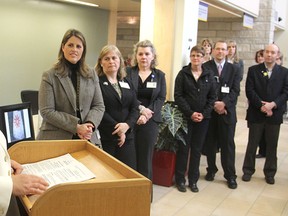Relay for Life kicks off

Article content
Denise Cumming wore two hats Wednesday as she helped launch this year’s Relay For Life, the annual fundraiser for cancer research.
As executive director of University Hospitals Kingston Foundation, the money-raising organization for the city’s hospitals, she chaired the kickoff of the event that will see more than 1,000 people spend the night rounding the track at the Royal Military College to raise money for cancer equipment, education, support and research.
“In this instance, I am going to take off my foundation hat and put on my patient hat,” she told a gathering of Canadian Cancer Society and hospital staff in the foyer of the Cancer Centre of Southeastern Ontario.
“Last year when we held this event celebrating the Relay For Life launch, I was six days past a lumpectomy. This year, I am one-year cancer free,” she announced to the applause of the crowd.
This year’s Relay For Life, held annually for the past 13 years to celebrate the lives of people like Cumming who beat cancer, or remember those who didn’t, will begin at 7 p.m. on Friday, June 7, and conclude at 7 a.m. on Saturday, June 8.
It always begins with a survivors’ lap, when those who have defeated the disease are acknowledged by the other participants.
More than 100 teams, each with about 10 people, are expected to take part.
Two years ago, the event raised $250,000. Even last year, when the relay was ended early because of the rain, $238,000 was raised.
Mary Hobbs, regional director of the Canadian Cancer Society, said the society would be teaming up with Kingston General Hospital and the University Hospitals Kingston Foundation for the relay.
“Our goal is to rally everyone in Kingston who cares about supporting people living with cancer to come out to the relay and celebrate the fact that today survivorship rates are higher than they ever have been before,” she said.
She asked the gathering to support “those who are in the thick of the struggle with their cancer diagnosis” and acknowledge those who have died of the disease.
“And most of all, unify ourselves in our determination to fight back against this disease.”
When cancer strikes our social circle, “many of us feel kind of powerless,” she said.
“There isn’t much we can do.”
She said the relay is a vehicle “to really do something positive in the face of this disease.”
She challenged the hospital and cancer centre staff to participate in the event, to even bring along some of their patients.
“What we are doing is helping to achieve the mission of both our organizations, which is to provide better care for people who are living with cancer, to see that cancer research keeps moving along and bringing us the advances that have brought us into better survivorship statistics, and to make sure there are those community services for information and support.”
Sherry Lemery, chair of the relay, said many people have wondered why the event is held overnight, instead of during the day.
She explained it mirrors the journey a cancer patient takes from diagnosis to, hopefully, a cure.
“Cancer does not stop for nighttime,” she said.
“Light and the darkness parallel the physical effects, emotions and mental state of cancer patients when they are undergoing treatment.”
The relay begins at sunset.
“This symbolizes the time when the person is diagnosed as having cancer. The day is getting darker and this represents the cancer patients’ state of mind as they feel their life is coming to an end.”
As the evening goes on, it gets colder and darker “just as the emotions of cancer patients do.”
The earliest hours of the morning represent the time the cancer patients start their treatment, she said. They become exhausted, some are sick, they don’t want to go on.
“As a participant, you have been walking and feeling much the same way. You are tired. You want to sleep, but you can’t. You can’t stop or give up just as a cancer patient cannot stop or give up.”
Then comes sunrise, representing the end of the treatments and, hopefully, a remission.
“They are tired, but they know they will make it. The sun is rising and it represents the end of the treatment for the cancer patients. They see the light of the day … and know that life will go on.”
The relay participants can also go through some strong emotions, she said.
“As a participant, you feel the brightness of the morning and you know that the end of the relay is close. When you leave the relay, think of the cancer patients leaving their last treatment. Just as you are exhausted and weak, so is that person after their treatment. But there is hope for the new day.”
The end of the relay isn’t the end of the fight, she said.
“There is no finish line until we have a cure.”
The track will be ringed by bags that contain a small candle. On the outside of each bag is the name of a loved one who either won their battle with cancer or succumbed to it.
The candles are lit at 10 p.m. to provide light and inspiration to the walkers as they round the track.
“That’s when we pause to remember why we are really there,” said Lemery. “Relay for Life is not just an event. It is a life-changing experience.”